2017 Activity Report for Mission 4: Development and Utilization of Wood-based Sustainable Materials in Harmony with the Human Living Environment
Updated: 2018/06/08
Prize in FY2017
Anselme Payen Award
Professor Junji Sugiyama was presented with the Anselme Payen Award at the ACS Division Cellulose and Renewable Materials following a symposium in his honor during the 2018 ACS Spring National Meeting in New Orleans, LA. Professor Sugiyama’s research interests include structure, biogenesis, biochemistry, and biophysics of cellulose microfibrils with particular emphasis of the state-of-the-art techniques for electron microscopy and crystallography.
the International Nanotechnology Division Awards and Fiber Lean Technologies Prize
Professor Hiroyuki Yano was awarded the International Nanotechnology Division Awards and Fiber Lean Technologies Prize by TAPPI (The Technical Association of Pulp and Paper Industry) for the development of cellulose nanofiber-reinforced plastic production process – “Kyoto Process”.
Research 1-1: Innovation of timber structure (Hiroshi Isoda, Akihisa Kitamori)
Based on the research for mechanical characteristics of new wooden materials such as cross laminated timber (CLT), we will develop new timber joints and construction system, and evaluate its structural performance which will contribute to the establishment of a sustainable society. We will also promote research on the composite structural members and buildings that combine wooden materials and wooden structures with other materials and structures in order to propose new developments in the use of wood.
Research Activities
- Study on earthquake resistance performance of CLT buildings in terms of structural member, mechanical joint and material properties.
- Development of hybrid floor system as timber-concrete composite structural member.
- Study on seismic reinforcement method using CLT shear panel infilled in steel frame.
Publications, etc.
- Hayato Furusawa, Akihisa Kitamori, Takuro Mori, Shinichiro Tamori, and Hiroshi Isoda: Development of Timber-Concrete Composite Floor System Proceedings of The 2nd Asia Research Node Symposium, Kyoto, Japan, 2017, July 19-21, Kyoto, Japan.
- Youta Ueda , Hiroshi Isoda and Akihisa Kitamori: Study on Compressive Strength of CLT Wall Panel under horizontal Loading, Proceedings of The 2nd Asia Research Node Symposium, Kyoto, Japan, 2017, July 19-2, Kyoto, Japan.
- Youta Ueda , Hiroshi Isoda and Akihisa Kitamori: Analysis of failure mechanism of CLT load-bearing-wall against horizontal force, The 7th International Symposium for Sustainable Humanosphere, 2017, Nov 1-2, Bogor, Indonesia.
- Kazumi Kanazawa, Akihisa Kitamori and Hiroshi Isoda: Case study on composite structure with CLT infilled in steel frames, The 7th International Symposium for Sustainable Humanosphere, 2017, Nov 1-2, Bogor, Indonesia.
- Satoshi Tanaka, Yusuke Otsubo, Takuro Mori, Yasuhiro Araki, Hayato Furusawa, Akihisa Kitamori and Hiroshi Isoda: Study on creep behavior of joint part of timber-concrete composite floor system, Proceedings of 12th China Korea Japan Seminar, 2017,Dec 18-20, Kyoto, Japan.
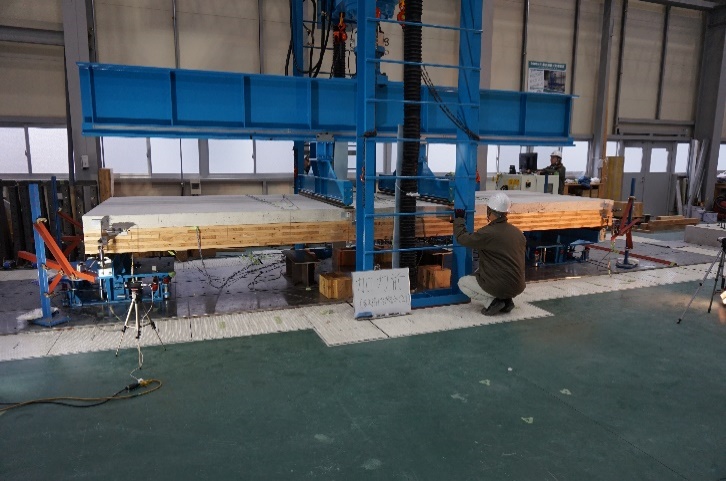 Bending test of Timber Concrete Composite specimen |
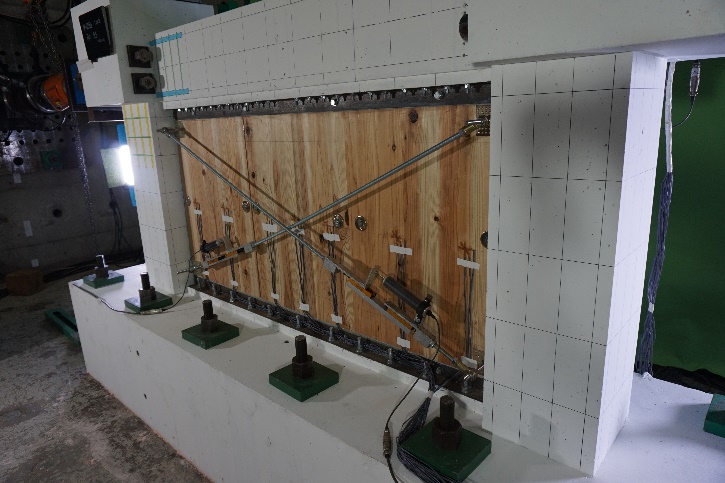 In-plane shear test of CLT shear panel infilled in steel frame |
Research 1-2: Evaluation of structural performance of existing buildings and development of seismic retrofitting techniques (Hiroshi Isoda, Akihisa Kitamori)
We will improve evaluation method of structural performance of wooden members / joints and structure, as well as developing an appropriate test method. Especially the analysis method for the shaking table test of the real-scale building will be studied.
Research Activities
- Evaluation of seismic performance of existing wooden building by shaking table test.
- Investigation on damage cause of wooden houses by earthquake.
Publication
Kotaro Sumida, Hiroshi Isoda: Experimental Seismic Response of a Full-Scale Japanese Conventional Wooden Post and Beam Building, Proceedings of 12th China Korea Japan Seminar, 2017, Dec 18-20, Kyoto, Japan.
Research 2: Quantitative morphology of woody plants (Junji Sugiyama et al.)
Promotion of research related to the wood collection maintained at the RISH Xylarium, with particular attention to a scientific analysis of the information engraved inside wood, and with the expectation that the knowledge obtained would provide the future direction of wood utilization toward a sustainable society.
Research Activities
- Automated wood identification by machine learning combined with image analysis.
- Wood identification by nondestructive methods.
- Wood science aided by use of a synchrotron radiation facility.
Research 3: From Production to Recycling of Wood Biomass-Based Materials(Kozo Kanayama, Kenji Umemura, Soichi Tanaka)
New wood-based materials in balance with both the global and regional environment are studied to develop production, utilization and recycling/disposal systems for wood biomass.
Research Activity
Controlling of penetration of obstacle for liquid permeation in impregnation of wood by applying water hammer.
Impregnation of wood with chemical liquids has been used to control the biodegradation and combustion. After the impregnation process, however, there often exist some areas without being filled with the liquid, leading to the inadequate control. This is mainly caused by the obstacle that blocks the liquid flow, e.g., the aspirated pits in tracheid of coniferous wood. This study focuses on the water hammer to penetrate the obstacle as follows. If the liquid fills up the cell cavities between the wood surface and the tip of the liquid permeation in wood, or the obstacles, the abrupt increase in the liquid pressure from one to another on the wood surface is expected to cause the damping oscillation in the liquid pressure at the obstacles, leading to penetrate them. The purpose of this study is to promote the liquid permeation into wood by applying the water hammer. It was indicated from the theoretical analysis that the water hammer occurred by the quick pressurization (Fig.1). The amount of the liquid taken up to the sample, however, showed no significant difference between the quick and slow pressurization. Analysis of the pressure variation suggests that the water hammer in this experiment was not so much large as affecting the penetration of the obstacle in wood. To enhance the strength of the water hammer, the amount of liquid passing through the valve per unit of time should be larger.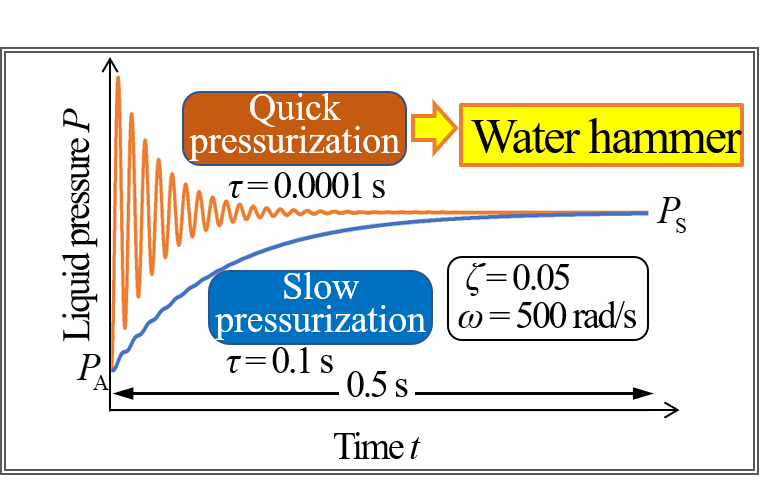 Fig.1 Analytical results for effect of pressurization rate on liquid pressure at obstacle for liquid permeation in wood.
Fig.1 Analytical results for effect of pressurization rate on liquid pressure at obstacle for liquid permeation in wood.
Publications, etc.
- Kamii Nakamura, Soichi Tanaka, Kenji Umemura, Kozo Kanayama:.Effect of water hammer phenomenon on liquid permeation in impregnation of wood, The 2nd Asia Research Node Symposium on Humanosphere Science (RISH), July, 2017.
- Kamii Nakamura, Soichi Tanaka, Kenji Umemura, Kozo Kanayama:Liquid permeation into wood influenced by impact pressure applied on surrounding liquid , Asia Research Node Workshop on Ligno-cellulosic Materials (LIPI) , October, 2017.
- Kamii Nakamura、Soichi Tanaka、Kenji Umemura、Kozo Kanayama:Effect of water hammer on liquid permeation into wood ―Experimental simulation on temporal variability of liquid pressure at the obstacle for liquid flow―, The 68th Annual Meeting of the Japan Wood Research Society, Kyoto, March 2018.
Research 4: Establishment of environmentally harmonized innovative recycling system of resources in the humanosphere (Tsuyoshi Yoshimura, Toshimitsu Hata, Aya Yanagawa)
Our research targets are a) to enhance the durability of wood-based materials based on fundamental researches, and b) to research and develop sustainable functional materials from wood. The present research topics are as follows:
- Ecology, physiology, and management of wood-deteriorating organisms.
- Sustainable functional materials from wood.
- Study of interactions between insects and microorganisms for biological control.
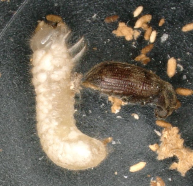 |
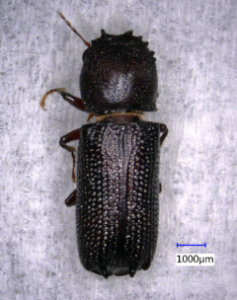 |
Establishment of mass cultures of wood-attacking beetles: Nicobium hirtum (left) and Heterobostrychus aequalis (right)
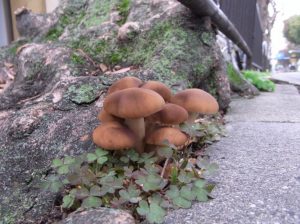 |
 |
Surveys on fungal infestation on street-trees (left) and ectoparasitic fungi on termites (right)
 Development of carbonized wood with high specific surface area
Development of carbonized wood with high specific surface area
Publications,etc.
- Yuliati Indrayani, Yoko Takematsu, Tsuyoshi Yoshimura (2017) “Diversity and distribution of termites in buildings in Pontianak, West Kalimanta, Indonesia”, BIODIVERSITAS, 18(3), 954-957, DOI: 10.13057/biodiv/d180312.
- Cihat Tascioglu, Kenji Umemura, Sukma S. Kusuma, Tsuyoshi Yoshimura (2017) “Potential utilization of sodium fluoride (NaF) as a biocide in particle board production”, J. Wood. Sci., 63(6), 652-657 (2017) DOI 10.1007/s10086-017-1654-z.
- Ikhsan Guswenrivo, Hiroki Sato, Izumi Fujimoto, Tsuyoshi Yoshimura (2017) “The first record of Antennopsis gallica Buchli and Heim, an ectoparasitic fungus on the termite Reticulitermes speratus (Kolbe) in Japan”, Jpn. J. Environ. Entomol. Zool., 28(2), 71-11.
- Cihat Tascioglu, Kenji Umemura Tsuyoshi Yoshimura (2018) “Seventh-year durability evaluation of zinc borate incorporated wood-plastic composites and particleboard”, Composites Part B, 137, 123-128.
- Toshimitsu Hata, Sensho Honma, Yoshikazu Onishi, Isamu Ide, Sylvie Bonnamy, Paul Bronsveld (2017) “Microstructural analysis of carbonized wood for CO2 capture”, Carbon 2017, Melbourne, 27 July.
- Toshimitsu Hata, Sensho Honma, Yoshikazu Onishi, Isamu Ide, Sylvie Bonnamy, Paul Bronsveld (2017) “Synthesis of Carbonized Wood for CO2 Capture”, CESEP’17, Lyon, 24 October.
- Wakako Ohmura, Kohei Kambara, Yoko Takematsu, Yoshiyuki Yanase, Tsuyoshi Yoshimura (2018) “Ecology and Management of Termites” in “Fundamentals of Termite and Decay Management”, The Japan Termite Control Association,pp12-56 (in Japanese)
- Toshimitsu Hata, Sensho Honma, Yoshikazu Onishi, Isamu Ide, Microstructure of porous carbonized wood for CO2 capture, 44th Annual Meeting of The Carbon Society of Japan,Kiryu, (Dec. 2017) (in Japaansese)
- Toshimitsu Hata, Sensho Honma, Yoshikazu Onishi, Isamu Ide, Improvement of CO2 Capture in Fe-doped Carbonized Wood, The 68th Annual Meeting of The Japan Wood Research Society in Kyoto (March 2018) (in Japanese)
Research 5: Production and utilization of cellulose nanofibers (Hiroyuki Yano, Kentaro Abe, Fumiaki Nakatsubo, Arimitsu Usuki)
A plant cell wall consists of nanofibers called cellulose nanofibers. We are developing high-strength and low thermal expansion nanocomposites based on nanofibers for use in automobiles, buildings, portable computers, medical devices, and many other products.
Research Activities
- Development of Cellulose nanocomposites using emulsion methods
- Improvement of Cellulose nanocomposites by surface modifications, etc.
Publications, etc.
- Agustin MB, Nakatsubo F, Yano H. (2018) “Improving the thermal stability of wood-based cellulose by esterification”, Carbohydrate Polymers 192, 28-36.
- Sakakibara K, Moriki Y, Yano H, Tsujii Y. (2017) “Strategy for the Improvement of the Mechanical Properties of Cellulose Nanofiber-Reinforced High-Density Polyethylene Nanocomposites Using Diblock Copolymer Dispersants”, ACS APPLIED MATERIALS & INTERFACES 9 (50), 44079-44087.
- Biswas Subir K, Sano H, Md. Iftekhar Shams, Yano H. (2017) “Three-Dimensional-Moldable Nanofiber-Reinforced Transparent Composites with a Hierarchically Self-Assembled “Reverse” Nacre like Architecture”, ACS APPLIED MATERIALS & INTERFACES, 9 (35), 30177-30184.
- Yamakawa A, Suzuki S, Oku T, Enomoto K, Ikeda M, Rodrigue J, Tateiwa K, Terada Y, Yano H, Kitamura S. (2017) “Nanostructure and physical properties of cellulose nanofiber-carbon nanotube composite films”, Carbohydrate Polymers, 171, 129-135.
- Suzuki K, Homma Y, Igarashi Y, Okumura H, Yano H. (2017) “Effect of preparation process of microfibrillated cellulose-reinforced polypropylene upon dispersion and mechanical properties”, Cellulose, 24 (9), 3789-3801.
- Wang L, Ando M, Kubota M, Ishihara S, Hikima Y, Ohshima M, Sekiguchi T, Sato A, Yano H. (2017) “Effects of hydrophobic-modified cellulose nanofibers (CNFs) on cell morphology and mechanical properties of high void fraction polypropylene nanocomposite foams”, Composites Part A: Applied Science and Manufacturing, 98 (1), 166-173.
- Agustin MB, Nakatsubo F, Yano H. (2017) “Improved resistance of chemically-modified nanocellulose against thermally-induced depolymerization”, Carbohydrate Polymers, 164 (15), 1-7.
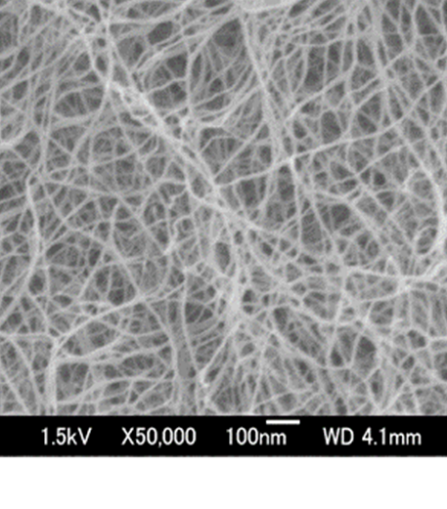 |
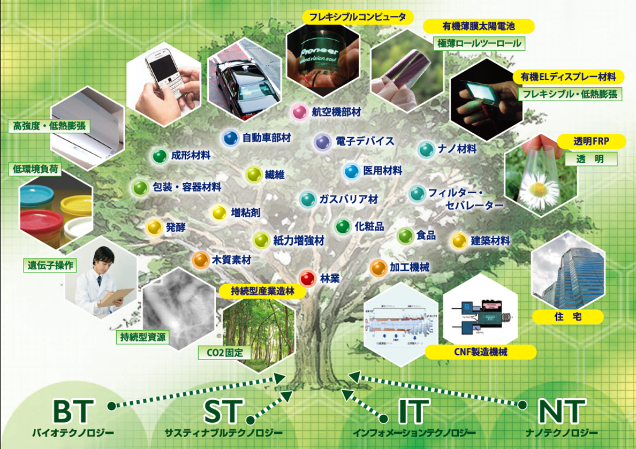 |


